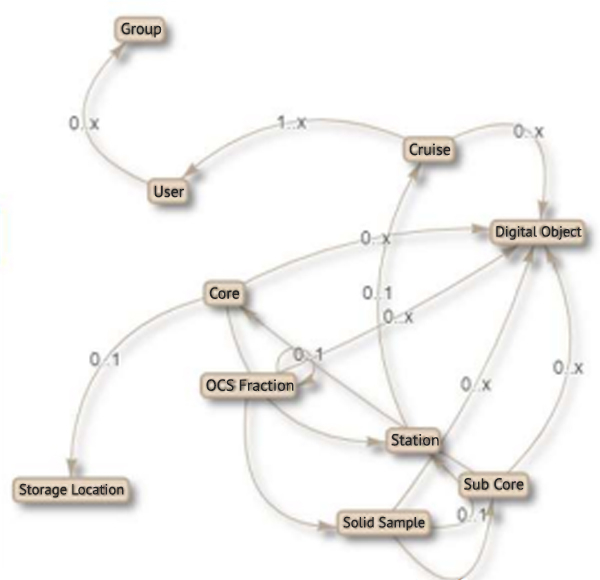DAS
DAS (Data Archive System) is a web-application, developed to help researchers in managing their research data from archiving raw or primary data to publishing the data under NIOZ DOI. Any digital object (DO) representing your research data such as text files, images, video footage etc. can be archived, provided a defined set of meta data is submitted. The DO itself is saved in a secured section of the NIOZ-network and is subject to the hourly back up routine of NIOZ. The metadata are stored in the DAS-database and serve the searching, identification and retrieval of your DO's via DAS.
DAS distinguishes Powerusers and Users.
Powerusers act on the level of a department and their privileges are set accordingly.
Users have a minimum set of privileges to manage their data.
Attributes and relationships
DAS is built upon user-defined attributes and relationships between those attributes. These attributes and relationships provide structure to your data archive and aid to search and retrieve your research data within DAS. DAS enables multiple schemes of attributes and relationships to be designed. A scheme reflects the way research is conducted and can thus be specific for a single researcher or for a cluster of researchers sharing a similar research-approach. A scheme is designed and set by RDM in consultation with the power-user of a department and may be modified/extended at the request of a researcher. DO's representing the raw/primary research data can be associated with any attribute of the scheme while being archived.
Example
Let's illustrate this with the scheme for a cluster of researchers within OCS, involved in seagoing research. Their research is conducted during a cruise, covering stations to collect sediment cores. These cores are sectioned into subcores from which samples are taken to be divided in fractions and analyzed. The scheme for this research cluster would look like:
cruise <-- station <-- core <-- subcore <-- OCS-sample <-- OCS-fraction,
where the arrows represent the relationship between attributes.
According to this generic OCS-scheme, an OCS-user may define specific stations, cores, subcores, samples, and fractions by providing the required metadata (such as dates, geo-position, water depth, core type etc.). Creating a specific cruise though is a privilege for the DAS administration and will likely be automated in the future. It's worth mentioning that DAS features an import routine (Excel based) that allows the upload of a large number of specific attributes, very useful e.g. in case many 'sample' attributes should be created for a 1m subcore with a vertical sampling resolution of 1 cm.
The creator of a specific attribute is by default the owner of that attribute and may decide on access (read and or update) by other users (e.g. the cruise party). As mentioned earlier, DO's can be archived while being associated with a specific attribute. For example, the cruise-report (textfile) can be archived and associated with the cruise, the event-list for a station can be associated with that specific station etc. Once the analysis on a fraction is done, the resulting datafile can be associated with that specific fraction or with multiple fractions in case the analyses results are aggregated in a single data file.
Uploading DO's to DAS
DO's can be uploaded manually by selecting the attribute of interest and upload the DO from its storage location. The DO will be archived and associated with the selected attribute. If an analytical device is hooked up to NIOZ-network, datafiles containing analytical results can be uploaded and associated with the attribute in an automated way. On creating a fraction for analysis (in the above example), DAS assigns a unique code to this fraction. This code should be fed to the analytical instrument (by hand or automated) and be reported in the datafile generated by this instrument after analysis. The instrument writes the datafile to a dedicated datafolder, known to DAS. DAS can be scheduled to monitor this folder, to archive each new datafile and to retrieve the unique fraction code from this file to establish the link with the corresponding attribute.
Searching and retrieving your data
DAS can be used to search and retrieve your data (DO's). Queries can be custom-built (and stored) to search your data. The query parameters can be selected depending on the meta data fields defined for the attribute of interest and the values provided for these parameters will constrain the results set. The results set (or a subset thereof), can be selected for download through a 'shopping-cart' principle. If you're not the (DAS-)owner of the requested data, the owner will receive an email to decide on granting you access to the data. Once access is cleared, you'll receive a notification to collect the requested data. This way, the sharing of research data across NIOZ is made easy while retaining full data access control.
If you have a question about DAS please let us know. Use the contact form on the right (preferred).


Architecture
Graphic: Environment graph of attributes and relations for a seagoing research group. Relations can be 1-to-1, 1-to-many, and many-to-1, mandatory or facultative.